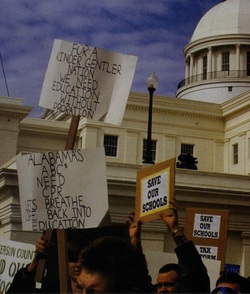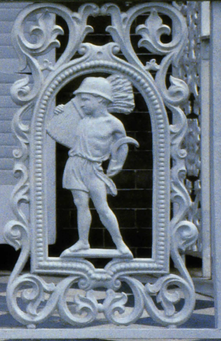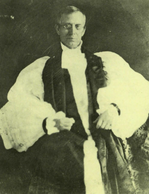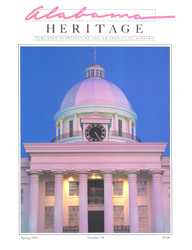|
On the cover: Alabama capitol, site of tax legislation since 1851. Photo by Robin McDonald.
Although this issue is no longer in print, scroll down to find some features from this issue that are available for purchase as downloadable PDFs.
|
FEATURE ABSTRACTS
 On February 4, 1992, several thousand Alabamians--members of parent-teacher associations and other concerned citizens--marched to the Alabama statehouse in Montgomery to voice support for tax reform and increased funding for education. (Courtesy George Wolfe)
On February 4, 1992, several thousand Alabamians--members of parent-teacher associations and other concerned citizens--marched to the Alabama statehouse in Montgomery to voice support for tax reform and increased funding for education. (Courtesy George Wolfe)
Taxes, Taxes, Taxes: The History of a Problem
By Wayne Flynt and Keith Ward
Alabamians hate taxes. When given the option between raising taxes and cutting social services, the choice seems simple: cut the services. This fact is not new; it is inextricably bound up in the history of the state. In this article, Wayne Flynt and Keith Ward examine the history of Alabama's attitude toward taxation and offer suggestions for tax reform.
By Wayne Flynt and Keith Ward
Alabamians hate taxes. When given the option between raising taxes and cutting social services, the choice seems simple: cut the services. This fact is not new; it is inextricably bound up in the history of the state. In this article, Wayne Flynt and Keith Ward examine the history of Alabama's attitude toward taxation and offer suggestions for tax reform.
Additional Information
About the Authors
Wayne Flynt, University Professor, Auburn University, is the author of seven books, most of them dealing with Alabama, its economic development and persistent poverty. His most recent book, Poor But Proud: Alabama's Poor Whites, was nominated for the Pulitzer Prize, won the 1990 Lillian Smith Prize for Non-Fiction (Southern Regional Council), the Alabama Library Association Award for Non-Fiction, the Jame F. Sulzby, Jr. Prize for best book on Alabama (Alabama Historical Association), and was selected Outstanding Academic Book for 1990-1991 by Choice, a publication of the American Library Association.
Keith Ward, Director, Center for Governmental Services, Auburn University, is one of Alabama's leading tax authorities. He has served with tax reform groups established by the governor, the speaker of the house, the State Department of Education, and the Torbert Commission. Ward recently received the Auburn University Extension Award for Excellence for his outreach efforts. His written and oral pronouncements on equitable tax structure can be expected to become the basis for future tax change.
- Cobb, James C. The Selling of the South: The Southern Crusade for Industrial Development, 1936-1980 (Louisiana State University Press, 1982).
- Kieschnick, Michael. Taxes and Growth: Business Incentives and Economic Development, vol. 11, Studies in Development Policy, edited by Michael Barker (Council of State Planning Agencies, 1981 ).
- McMillan, Malcolm C. Constitutional Development in Alabama, 1798-1901: A Study in Politics, the Negro, and Sectionalism (The University of North Carolina Press, 1955).
- Smith, Guthrie J. "Trends in the Tax System of Alabama," (M.A. thesis, University of Virginia, 1936).
- Thornton, J. Mills, III. "Fiscal Policy and Failure of Radical Reconstruction in the Lower South," in Region, Race, and Reconstruction: Essays in Honor of C. Van Woodward, edited by J. Morgan Kousser and James M. McPherson (Oxford University Press, 1982).
- Wright, Gavin. Old South New South: Revolutions in the Southern Economy Since the Civil War (Basic Books, 1986).
- The Alabama Revenue System: Report of the Revenue Survey Committee, An Interim Committee of the 1945 Legislature (Montgomery: January, 1947).
- Current Tax Problems in Alabama: A Report of the Committee on the Revision of the Tax Laws (Montgomery: June, 1957).
- Report of the Joint Continuing Committee to Study the Tax Structure of the State of Alabama and the Distribution of Taxes (Montgomery: The 1981 Legislature, January, 1981).
- A Legislator's Guide to Alabama Taxes: A Summary of the Major Revenue Sources of the State of Alabama (Montgomery: Legislative Fiscal Office, January, 1991).
About the Authors
Wayne Flynt, University Professor, Auburn University, is the author of seven books, most of them dealing with Alabama, its economic development and persistent poverty. His most recent book, Poor But Proud: Alabama's Poor Whites, was nominated for the Pulitzer Prize, won the 1990 Lillian Smith Prize for Non-Fiction (Southern Regional Council), the Alabama Library Association Award for Non-Fiction, the Jame F. Sulzby, Jr. Prize for best book on Alabama (Alabama Historical Association), and was selected Outstanding Academic Book for 1990-1991 by Choice, a publication of the American Library Association.
Keith Ward, Director, Center for Governmental Services, Auburn University, is one of Alabama's leading tax authorities. He has served with tax reform groups established by the governor, the speaker of the house, the State Department of Education, and the Torbert Commission. Ward recently received the Auburn University Extension Award for Excellence for his outreach efforts. His written and oral pronouncements on equitable tax structure can be expected to become the basis for future tax change.
 The Charles G. Richards House, constructed in 1860, contains perhaps the most intricate ironwork in the city, blending naturalistic patterns with neoclassical elements, including allegorical figures of the four seasons. (Courtesy Mobile Historic Development Commission)
The Charles G. Richards House, constructed in 1860, contains perhaps the most intricate ironwork in the city, blending naturalistic patterns with neoclassical elements, including allegorical figures of the four seasons. (Courtesy Mobile Historic Development Commission)
Old Mobile Ironwork
By John Sledge
Flamboyant, yet practical, cast iron captured the imagination of America. The infinite variety of forms possible in cast iron made it desirable for architects seeking to add dramatic flair to their buildings. In no area of the country was it more appreciated than in coastal cities such as Mobile, Alabama. The history of the metal, however, is by no means straightforward: at once prized and neglected, imitated and sold for scrap, cast iron weathered the twentieth century to become an integral part of Mobile.
Additional Information
Gamble, Robert S. The Alabama Catalog (University of Alabama Press, 1987).
Gloag, John, and Derek Bridgewater. A History of Cast Iron in Architecture (Allen & Unwin, 1948).
About the Author
John Sledge, architectural historian for the Mobile Historic Development Commission, has a master's degree in historic preservation from Middle Tennessee State University. His interest in cast iron is long-standing: A a child he enjoyed playing on the iron hitching post in front of his grandmother's antebellum home in Mobile. "This article will have succeeded," he says, "if it evokes an appreciation for old downtown Mobile, now fallen on such hard times."
By John Sledge
Flamboyant, yet practical, cast iron captured the imagination of America. The infinite variety of forms possible in cast iron made it desirable for architects seeking to add dramatic flair to their buildings. In no area of the country was it more appreciated than in coastal cities such as Mobile, Alabama. The history of the metal, however, is by no means straightforward: at once prized and neglected, imitated and sold for scrap, cast iron weathered the twentieth century to become an integral part of Mobile.
Additional Information
- Antwerp, Emily S. Van. Iron Ore to Iron Lace (Museum of the City of Mobile, 1980).
- Benjamin, Asher. Practice of Architecture (published by the author and Carter, Hendee & Co., 1833), Reprint DaCapo Press, New York, 1972.
Gamble, Robert S. The Alabama Catalog (University of Alabama Press, 1987).
Gloag, John, and Derek Bridgewater. A History of Cast Iron in Architecture (Allen & Unwin, 1948).
- Gould, Elizabeth B. From Fort to Port: An Architectural History of Mobile, Alabama, 1711-1918 (Tuscaloosa: University of Alabama Press, 1988).
- Ingate, Margaret Rose. "Mobile Ironwork," Antiques 92 (September 1967): 354-59.
- Southworth, Susan and Michael. Ornamental Ironwork: An Illustrated Guide to Its Design, History & Use in American Architecture (Boston: David R. Godine, 1978).
- Wilkinson, Jeff. "Architectural Ironwork: Cast and Wrought," Old-House Journal (January/February 1990):
- 20-21.
About the Author
John Sledge, architectural historian for the Mobile Historic Development Commission, has a master's degree in historic preservation from Middle Tennessee State University. His interest in cast iron is long-standing: A a child he enjoyed playing on the iron hitching post in front of his grandmother's antebellum home in Mobile. "This article will have succeeded," he says, "if it evokes an appreciation for old downtown Mobile, now fallen on such hard times."
 The Right Reverend Nicholas Hamner Cobbs, first Episcopal bishop of Alabama, prayed that he would die before Alabama,a seceded from the Union. He passed away on January 11, 1861, an hour before the event occurred. (Courtesy Alabama State Department of Archives and History)
The Right Reverend Nicholas Hamner Cobbs, first Episcopal bishop of Alabama, prayed that he would die before Alabama,a seceded from the Union. He passed away on January 11, 1861, an hour before the event occurred. (Courtesy Alabama State Department of Archives and History)
Praying for the President
By Janie M. Moore
Church and State collided during Reconstruction when Alabama's Episcopalians refused to pray for the US president. Though such prayer was common in the era before the Civil War, representatives of the Episcopal church argued that it was their right to refuse prayer for the president, arguing that--since he was the head of an occupying force--his rule was illegitimate. In response, the Union army issued General Orders 38, which threatened military closure of the churches until such a time as their leaders agreed to re-institute the prayer. The confrontation between these two stances was intense and would result in an appeal to the subject of the prayer himself--Pres. Andrew Johnson.
Additional Information
Brydon, G. MacLaren. "The Confederate Prayer Book," Historical Magazine of the Protestant Episcopal Church 17 (1948): 339-44.
Cheshire, Joseph Blount. The Church in the Confederate States (Longmans, Green, and Co., 1914).
About the Author
Janie Moore, a native Alabamian, holds master's degrees in English and social work from the University of Alabama. She has long been interested in the history of the Episcopal church. Moore and the editors wish to thank the Reverend Emmet Gribbin of Tuscaloosa, Jim Wood of Mobile, and Pat Cather of Birmingham, for assistance with the article.
By Janie M. Moore
Church and State collided during Reconstruction when Alabama's Episcopalians refused to pray for the US president. Though such prayer was common in the era before the Civil War, representatives of the Episcopal church argued that it was their right to refuse prayer for the president, arguing that--since he was the head of an occupying force--his rule was illegitimate. In response, the Union army issued General Orders 38, which threatened military closure of the churches until such a time as their leaders agreed to re-institute the prayer. The confrontation between these two stances was intense and would result in an appeal to the subject of the prayer himself--Pres. Andrew Johnson.
Additional Information
Brydon, G. MacLaren. "The Confederate Prayer Book," Historical Magazine of the Protestant Episcopal Church 17 (1948): 339-44.
Cheshire, Joseph Blount. The Church in the Confederate States (Longmans, Green, and Co., 1914).
- "Civil War Days in Huntsville: A Diary by Mrs. W. D. Chadick," Alabama Historical Quarterly 9 (Summer 1947). Reprinted from the Huntsville Times.
- Whitaker, Walter C. Richard Hooker Wilmer, Second Bishop of Alabama: A Biography (George W. Jacobs & Co., 1907).
- _____ . History of the Protestant Episcopal Church in Alabama: 1763-1891 (Roberts & Son, 1898).
- Wilmer, Richard H. The Recent Past from a Southern Standpoint: Reminiscences of a Grandfather (Thomas Whittaker, 1887).
About the Author
Janie Moore, a native Alabamian, holds master's degrees in English and social work from the University of Alabama. She has long been interested in the history of the Episcopal church. Moore and the editors wish to thank the Reverend Emmet Gribbin of Tuscaloosa, Jim Wood of Mobile, and Pat Cather of Birmingham, for assistance with the article.
DEPARTMENT ABSTRACTS
Southern Architecture and Preservation
Gothic Revival Architecture in the Canebrake
By Jeff Mansell
While the Classical and Greek Revival styles were the most popular choices for plantation owners, romantic architectural styles such as the Italianate and the Gothic Revival gained increasing favor in the 1850s. Two examples of the Gothic Revival style are found in the Canebrake region of Alabama. Jeff Mansell discusses the history and influence of these houses.
About the Author
Jeff Mansell is assistant director, Cahaba Trace Commission.
Gothic Revival Architecture in the Canebrake
By Jeff Mansell
While the Classical and Greek Revival styles were the most popular choices for plantation owners, romantic architectural styles such as the Italianate and the Gothic Revival gained increasing favor in the 1850s. Two examples of the Gothic Revival style are found in the Canebrake region of Alabama. Jeff Mansell discusses the history and influence of these houses.
About the Author
Jeff Mansell is assistant director, Cahaba Trace Commission.
